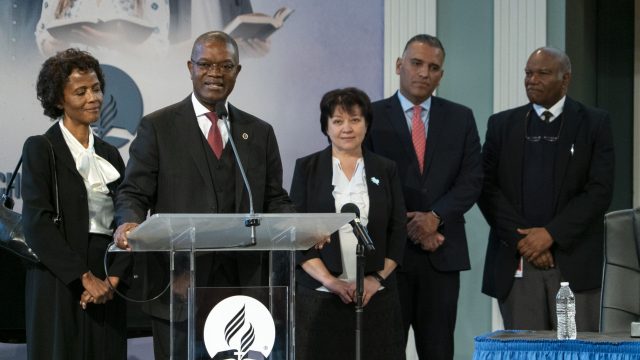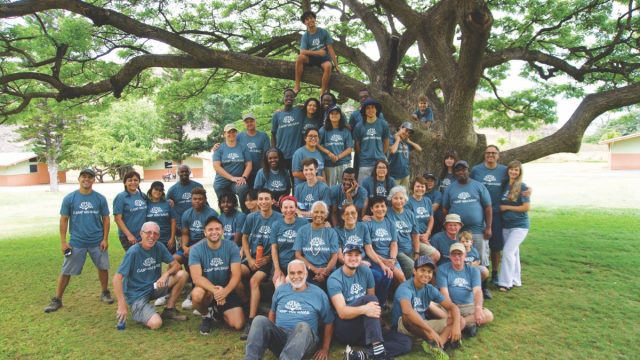Social media allows us to share our faith and engage with our community when it’s most convenient.

It’s hard to knock on someone’s door, even if we already know them. In fact, it’s not even socially acceptable nowadays to just show up unexpectedly at someone’s house in case they are busy when we stop by. We must call and schedule a visit first. Add the need for social (physical) distancing, and it becomes clear that the old way of evangelizing can no longer be the primary method.
But you don’t have to knock on a stranger’s door to share your faith. Nor do you have to create the content. Canvassers are not also the authors of the books they sell. The burden of content creation is not for all of us.
Social media allows us to share our faith and engage with our community when it’s most convenient for them. It allows our audience to self-select whether or not they want to engage.
Young people spend upwards of 9 to 18 or more hours behind a screen each day. That’s a lot of opportunities for us to share and reach people anywhere. Excluding periods of sleep and quarantine, how many people are normally home nine hours a day to answer the door? In normal daily life, many people leave the house early and come home late at night.
Digital door-knocking means sharing spiritual content on your social media profiles or through messaging and email to create an opportunity for people to engage with you about your faith. The spiritual content can be anything (a picture, text, video, blog, and so on); just be sure to include with it a personalized message about how it impacted you. Your friends and followers can scroll past it or choose to engage when it’s convenient for them.
Given that a lot of people could be stuck at home with extra time on their hands because of COVID-19 or a future crisis, social media may be their main source of entertainment and connection. There are a lot of opportunities right now for us to share and reach people everywhere using digital technologies. Success can no longer be measured only by counting people in a building. We must consider whether or not we’re building a kingdom.
World-of-Mouth Opportunities Online
Word-of-mouth is still the strongest marketing mechanism for getting the word out about a product or cause. People always trust the opinion of their friends and family over what a brand says about itself. This is why reviews and testimonies are so powerful.
We participate in word-of-mouth marketing every time we share about a product or experience with others. We might share something in person, but word-of-mouth marketing often takes place on social media and through messaging applications and texting. We do this constantly when it comes to our other interests and don’t even realize it.
In terms of sharing the gospel, this just means doing the thing you do all the time online but doing it for the kingdom. In other words, be intentional with what you share.
Some Digital Ways You Can Distribute the Adventist Messages
You may have a habit of sharing in one digital medium already, but you can diversify with these activities:
- Forward emails
- Send text invitations with a link to contacts, or send invitations via messenger apps
- Share content from your church’s profiles or a ministry you follow and add a personalized message
- Live-stream events, sermons, Bible study groups, and so on, from your social media profiles
- Hit “Like,” “Love,” or “Wow” on ministry Facebook posts to increase organic reach
- Post to community groups or apps like Nextdoor about upcoming events
- Find digital ways to connect with neighbors and community; then share your faith with them
- Follow, “friend,” or join online Christian groups to help increase their digital influence
Leverage Social Influence Through Pods
Create a culture of sharing and content engagement within your church community. Nearly everyone is on social media. Even if you have an older congregation, a good many of them are likely on Facebook and have an email address. Don’t assume that they are not; ask and find out what platforms they use.
Social influence can be both analog and digital. Churches do well with analog distribution (printed flyers, for example); however, we need to start leveraging the digital social influence of our members. Even in a small church with 50 congregants, if half were on social media and were connected to just 50 people within the community (outside of the congregation), that’s a potential reach of 1,250 people. This is a low estimate, but you get the idea.
Train your membership to function as a social media “pod.” A “pod” is a group that increases engagement on social media platforms like Instagram and Facebook, and this can apply even to email use. Members of a pod agree to comment, “Like,” and share each other’s content or the content of a particular entity such as a church or ministry. Teach your members to engage and share your church content weekly as a form of evangelism and outreach.
Pod commitments vary but typically fall into three categories:
- All users must engage with every post within an hour
- All users must engage with every post within 24 hours
- All users must engage with relevant posts whenever they can
A congregation that understands the value of participating in ministry this way could serve as a powerful reach vehicle for souls. To realize this potential, they must be equipped and encouraged. Determine members’ strengths and train them to use their strengths.
Be sure to:
- Take time in meetings and during service or choir rehearsals to prioritize technology
- Provide hands-on training to church members
- Ask them to take out their phones and take action right in the moment
- Empower a designated person to post about key events to local groups or community apps like Nextdoor
- Encourage members to mark Facebook events with “Going” or “Interested” to increase organic reach
- Encourage them to invite others to events via email and/or text or on Facebook
- Encourage them to “Like,” “Wow,” or “Love” relevant content on your Facebook profile (and other social media platforms); this increases organic traffic
- Tell them when to expect emails and ask them to forward emails to their contacts
- Send out weekly emails with links to content you want members to share or engage with
- Keep them posted on how their efforts are working and create a sense of teamwork
- Get them excited about digital discipleship through sharing your excitement and testimonies about how it has worked
Holiday Test Case
My local church is predominantly older people, and we have around 200 members — not a megachurch by any standard. For our holiday programs and special events, the leadership asks me to lead promotion.
Beyond targeting the community with social advertising, I also spend a lot of time rallying the membership to hand out flyers, forward emails, share on social media, text people, and so on. This is new for them and out of their comfort zone, but we are a close-knit community, and our members do seek to help each other.
At the end of our six-week campaign for our annual Christmas play, 393 tickets had been reserved in advance, and on the day of the event, we packed the house with around 500 in attendance. Now, the our metropolitan area has a lot of holiday event opportunities, so people did not have to choose us. By and large, most people who reserved tickets online said they had heard about the event from a friend or family member via email or social media. Word-of-mouth outperformed paid social advertising. For our previous event at Easter, by contrast, with no promotion strategy and much less event competition in the area at that time, only 100 tickets were reserved in advance.
After the Christmas play, we sent a follow-up survey to gather feedback to better understand our audience and let them know that we valued their opinion. This allowed us to understand how many non-Adventists attended the program. In this case, 20 percent of survey respondents were not Adventists. It also gave us an opportunity for service by adding this question: “Is there anything we can help you with? Let us know how we can bless you, and please provide your contact information.”
Here is an example of how, with the right coaching, even an older congregation can realize their untapped potential for helping their church better reach the local community through increased awareness. For my congregation, this example served as a test run and, since then, all the tickets for our special programs have been reserved in advance of the event.
This promotional activity had immediate results, but having a congregation that consistently engages in digital door-knocking would have a long-tail effect that we may not fully appreciate this side of heaven. Using this model, our messages of hope and wholeness could be spread to every corner of the digital space and, while not everyone can walk through the door of a church, they will be able to connect with God.
The original version of this blog post appeared on the North American Division’s Big Data and Social Media blog.








